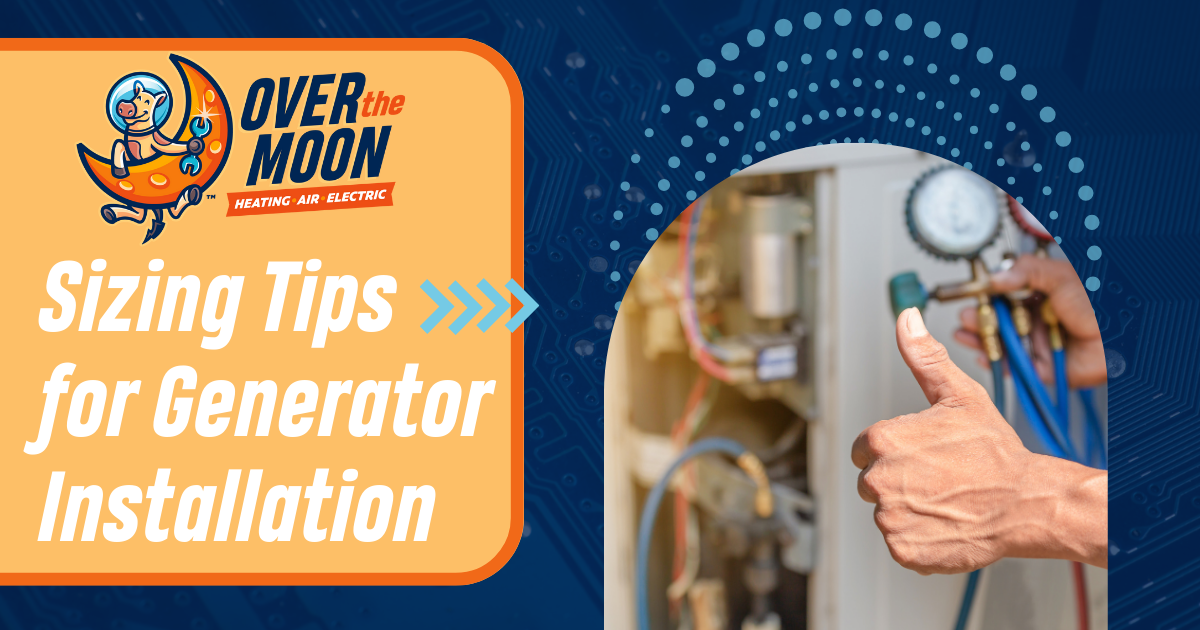With proper sizing, generator installation can ensure the lights stay on, food stays cold, and your HVAC system keeps running during a power outage. The installation process is challenging enough; you need a certified electrician. But sizing a home generator must be done carefully for the project to be a success. These tips will help you make the right decisions:
List What Needs to Be Powered
You’ll need to know the capacity required in watts (W) before choosing a generator of a certain size. A device’s wattage rating can usually be found in the user manual or on the equipment’s nameplate. Approximate running wattages for common household appliances and equipment include:
- Refrigerator/Freezer: 600 W to 800 W
- Microwave: 1,200 W
- Toaster: 1,100 W to 1,700 W
- Electric Oven: 5,000 W
- Hair Dryer: 1,200 W to 1,500 W
- Coffeemaker: 400 W to 800 W
- Vacuum Cleaner: 700 W to 1,400 W
- Water Heater: 3,000 W to 4,500 W
- Central AC: 2,000 W to 4,000 W
- Electric Furnace: 5,000 W to 25,000 W
- Sump Pump: 1,500 W
- Table Lamp: 150 W
- Outdoor Lighting: 500 W to 1,000 W1
These are just some rough examples. To calculate load size, add up all the wattage ratings for every appliance you need a generator to power.
Consider Starting/Running Wattage
Total wattage combines the running wattage and starting wattage of appliances. A generator must handle the peak wattage so momentary increases in power demand, such as when an AC first starts up, don’t overload or damage the unit. Therefore, use the formula: Running Wattage + Starting Wattage = Total Wattage.
Understand Power Conversions
Once you add up the total wattage of your appliances, electronics, and devices, you’ll get the full power requirement in kilowatts (kW). However, generators are rated in kilo-volt-amperes (kVA). Rather than measuring the actual power, kVA is a measure of apparent power (or the power in use in a system). If kW=kVA, a system is 100% efficient, but no electrical system is.
Not all the apparent power is used to produce a useful work output, but converting between kVA and kW will help you determine an electrical system’s efficiency, which is rated from 0 to 1. A power factor of 0.8 is an international standard for generators. It helps match the size of your load to a generator.
For example, if your equipment has a total load of 100 kW, you’d need a generator able to produce a minimum of 125 kVA (100 kW / 0.8 = 125 kVA).
To convert to kilowatts, use this formula instead: 100 kVA x 0.8 = 80 kW.
Assess Site Conditions
Load size isn’t the only consideration when sizing a generator. Once you know your power requirements, you must determine if they are feasible. Where are you going to install the generator? A narrow access point can make offloading the generator difficult, as can off-road conditions or uphill travel for the delivery vehicle. There must be enough room to operate the equipment to offload and place the unit, not to mention for the generator to fit and run safely.
Know What Type of Generator You Need
A home standby generator can provide up to 20,000 watts of electricity. It is permanently installed next to your home and turns on automatically if there’s a power outage. It runs on natural gas or propane and is wired directly to your electrical panel. Although convenient, it’s the largest and most expensive generator option (it can cost up to $6,000).1
A standby generator isn’t always the best option, especially if you don’t need one. It shouldn’t be installed if your home is prone to flooding, as the unit can’t be moved during a flood and water will render it unsafe and unusable.
Other options for generator installation include:
- Recreational Inverter Generator: It is lightweight and costs about $400 to $1,000.1 It is easily transported and requires no installation but can power a refrigerator, lights, and smaller electronics. It can meet your needs if power outages are rare in your area.
- Mid-Sized Inverter Generator: Costing $1,000 to $1,700, it delivers up to 3,500 W.1 It can power a refrigerator and lights for up to 18 hours (it’s not suited for powering heating or cooling equipment). All the while, it’ll need just two or three gallons of gas.
- Large Inverter Generator: Weighing up to 350 pounds, it provides 7,500 W of power and costs from $1,400 to $4,000.1 It can power refrigerators and small air conditioners. You’ll need stabilized gasoline to run this type of generator.
- Portable Generator: A portable unit also offers up to 7,500 W. It costs between $700 and $2,800 and isn’t exactly lightweight, but is suited for camping or tailgating.1 Many portable generators can meet the demands of an average household and be hardwired to equipment and a circuit breaker at a significant cost.
Contact Over the Moon for Generator Installation
We provide whole-home generator installation in Waukesha County, WI. Our high-quality solutions will meet your electrical needs when the power goes out due to extreme weather or other reasons. Trained, licensed, and certified, our electricians can install any home generator brand, make, or size of the home generator, ensure it’s reliable, and avoid safety issues. To learn more, schedule service online or call (262) 240-6519.
Source:

